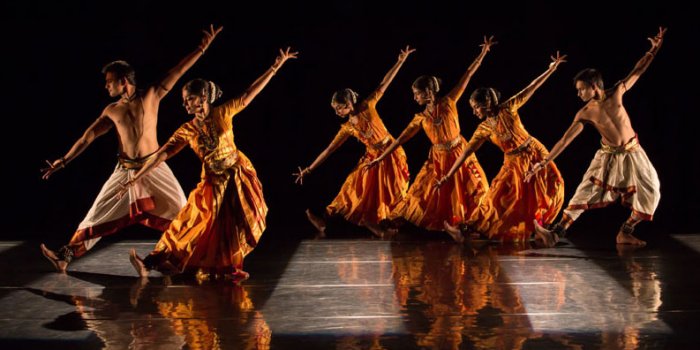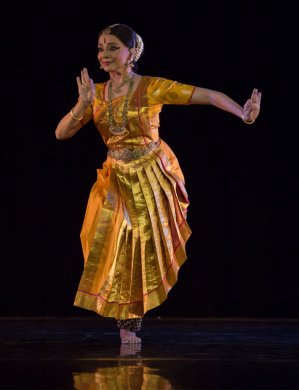
|   |

|   |
 e-mail: leelakaverivenkat@gmail.com Thari exquisitely weaves the warp and weft of life's saree Photos: Shalini Jain October 17, 2017 There is no flamboyance or over abundantly grand narrative. But in the 75 minutes of non-stop group presentation in Thari -The Loom conceived and choreographed by Malavika Sarukkai, the audience after having experienced artistic excellence of exquisite subtlety, leaves the auditorium with a mind filled with the lurking poetry hidden in that unstitched traditional garment - the saree. Reflecting on the primeval rhythm tat taka taam of the loom, grew the perception in Malavika of how closely the very different activities of dance and weaving are guided by the same concerns, to quote the words of Thari's creative collaborator Sumantra Ghosal of "space, structure, motif, symmetry, proportion, relationship (and ) alignment." Much like the coming together of the warp and the weft in weaving, dance and music are required to work in "total coordination, rhythm and measurement and design." The production, lacing the proven movement technique in Bharatanatyam with the alchemy of the choreographer's creative contemporary mind, converts past inheritance into not something back there and lost, but a vital presence constantly alive, expanding its horizons. From start to finish the production speaks of a deep process of internalisation, of absorbing the rhythmic sounds of the loom into one's consciousness, of putting all the recurring thoughts through a shredding machine with constant dialoguing with Sumantra Ghosal. It is a question of processing sensibilities to work out how to translate what one feels into dance movement and in the final stages what one arrives at amounts to a rediscovery of your dance, the result of a felt experience. A compelling contributory factor was Sandhya Raman's costume designing, which could not have fructified without constant visits to Chennai and Bangalore for interactions and watching rehearsals and working out the eye catching colour combinations. Using only Kancheepuram silk and brocade the costume was designed with a rear kachha, a distinguishing factor being the beautiful fall and micro pleating details. The subtly sophisticated, classic nature of a combination in rust and burnt orange, or a base yellow ochre with green, red and pink borders (seen in the Ganga/Jamuna saree borders), with even the Spindles (parivattam) with yarn wound round it looking so elegant, spoke of great attention to details, and the total effect was classy without ever straying into being gaudy or overdone.  The curtain goes up to the incisive sounds of the working loom with four dancers rising from their majestic muzhumandi position slowly coming alive, with beautifully synchronised steps and jumps to the tat taka taam konnakkol by Sheejith Krishna with fine mridangam interventions by Nellai D. Balaji, the dancers elegantly flashing spindles in different colours. Sai Shravanam's painstaking location sound recording and creative editing produced the kalapramanam, for this rhythm composition, with the dance movements composed to faithfully accommodate the given. The loom with its warp with vertical threads stretched tight with the weft crisscrossing horizontally through it, would seem to have spun and inspired many a poetic metaphor. One recollects Henry Vaughan, the 17th century poet: "Man is the shuttle to whose winding quest /and passage through these looms, God ordered motion, but ordained no rest." Malavika sees the loom as a metaphor of life itself. The taut warp represents the inevitable constant, stretched across two ends of the spectrum of life and death - a metaphor for the call of Krishna's everlasting flute music. Moving gracefully crisscross, the weft, creating design and colour symbolises for Malavika, Radha's desire, delicately embracing Krishna. The dance visualisation for this entire concept is brilliantly conceived and rendered with Úlan, the largely abstract composition presented by meticulously trained dancers marking performance space in parallels and intersections. The immaculate coordination revelled in Bharatanatyam movements and rhythm, replete with the precise geometry of movement lines - vertical and the horizontal. The abstract musical base of solfa passages and rhythmic syllables set in a ragamalika/talamalika format , composed by Aditya Prakash, begins with Shankarabharanam, followed by ragas Purnachandrika, Karaharapriya, Behag, Dhanyasi, Kalyani, Ahirbhairav, Jeth. The finale of a fleeting solo sringar abhinaya, persuasive in minimalism, and rendered by Malavika was based on a Surdas pad.  Malavika Sarukkai Kancheevaram sarees in different hues hanging from the roof provided an aesthetic and colourful visual spectrum along with Malavika's voice in a first person recounting of how this unstitched garment, to which she was introduced by her late mother, was synonymous with her personality, its colours making a statement reflecting her state of mind and emotion . Like an endless river with its flowing space between the two banks, the saree with its Ganga and Jamuna borders becomes the metaphor for life itself, with its endless ebb and flow. The saree binds but also frees one with its open space. The music in Mayamalawagowla conceived by Prof. C.V. Chandrasekhar saw the dancers moving along the four edges of the performance space symbolising the borders. The movement language in a leg and hand stretch flowing from a central posture exuded a sense of amplitude in movement circumference, radiating a feel of freedom. The final very colourful segment on saree motifs was incisive in brevity - marked by innovative dance imagery, quite different from the conventional. The very first motif was the kili (the parrot) very closely associated with the sringar sentiment, for the bird is the vahana of Manmatha, the god of love, whose flowered arrows fill the victim with the agonies and ecstasy of love. Holding the sukatunda mudra, two dancers, to music set to Reetigaula catch the spirit of this motif. The next powerful scene was spun round the peacock motif, this bird being the vahana of Subrahmanya. Rather than the hackneyed peacock imagery and dance with the colourful plumes spread fanlike, here it was mayilkann (peacock-eye, a frequent motif in sarees) full of power as it piercingly spots its enemy the snake, and kills it. Unforgettable was the conviction in Malavika's stance as the peacock, shuffling the ground with one raised foot, preparing for the final onslaught, sharp eyes unblinkingly focussed on the enemy - the snake (demonstrated by Jyotsna Jagannathan) with the music sung by Murali Parthasarathy in Shanmukhapriya. The last motif was of the annapakshi or hamsa, the mythical swan, equally at home in land, water, and flying in the air visualised in the dance narrative in a group arrangement. After this bird which carries the goddess of learning Saraswati (music set to raga Hamsadhwani), the final inimitable touch was a benediction with tiny lights like stars twinkling on the dancers' bodies which get less and less seen till they disappear, with only the lights twinkling. The audience at the end, erupted in lusty applause for a superb presentation, the hallmark of maturity being the sense of proportion sans any over statement of any type. The excellently recorded music also comprised Srilakshmi Venkatramani (violin), Bhavani Prasad (veena), Vishnu Vijay (flute) and L. Kishore Kumar (sitar). For a generally word-bound dance culture, Malavika by using abstract dance to tell a story has pulled off a feat. Thari for me ranks as the composer's most evolved statement on group work.  Writing on the dance scene for the last forty years, Leela Venkataraman's incisive comments on performances of all dance forms, participation in dance discussions both in India and abroad, and as a regular contributor to Hindu Friday Review, journals like Sruti and Nartanam, makes her voice respected for its balanced critiquing. She is the author of several books like Indian Classical dance: Tradition in Transition, Classical Dance in India and Indian Classical dance: The Renaissance and Beyond. Post your comments Please provide your name and email id when you use the Anonymous profile in the blog to post a comment. All appropriate comments posted with name & email id in the blog will also be featured in the site. |